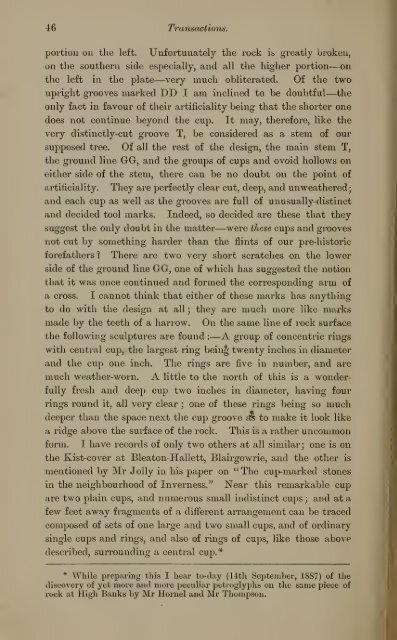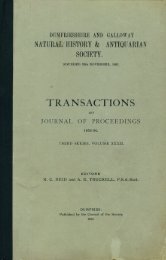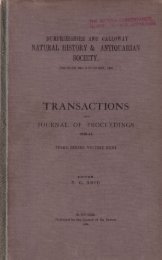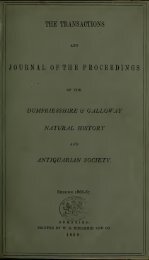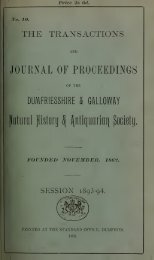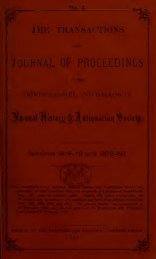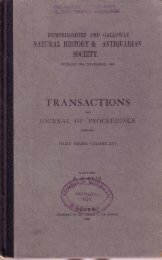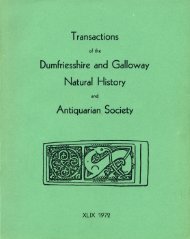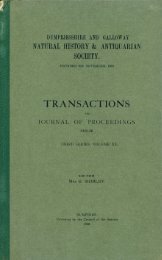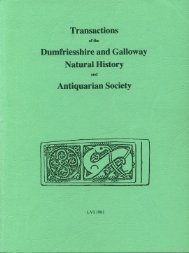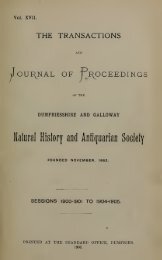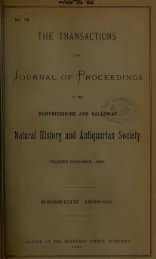146 Transactions.poi'tion on the left. Unfortunately the rock is greatly broken,on the southern side especially, <strong>and</strong> all the higher portion—onthe left in the plate—very much obliterated. Of the twoupright grooves marked DD I am inclined to be doubtful—theonly fact in favour of their artificiality being that the shorter onedoes not continue beyond the cup. It may, therefore, like thevery distinctly-cut groove T, be considered as a stem of oursupposed tree. Of all the rest of the design, the main stem T,the ground line GG, <strong>and</strong> the groups of cups <strong>and</strong> ovoid hollows oneither side of the stem, there can be no doubt on the point ofartificiality.They ai'e perfectly clear cut, deep, <strong>and</strong> unweathered;<strong>and</strong> each cup as well as the grooves are full of unusually-distinct<strong>and</strong> decided tool marks. Indeed, so decided are these that theysuggest the only doubt in the matter—were these cups <strong>and</strong> groovesnot cut by something harder than the flints of our pre-historicforefathers? There are two very short scratches on the lowerside of the ground line GG, one of which has suggested the notionthat it was once continued <strong>and</strong> formed the corresponding arm ofa cross. I cannot think that either of these marks has anythingto do with the design at all ; they are much more like marksmade by the teeth of a harrow. On the same line of rock surfacethe following sculptures are found :—A group of concentric ringswith central cup, the largest ring bein^ twenty inches in diameter<strong>and</strong> the cup one inch. The rings are five in number, <strong>and</strong> aremuch weather-worn. A little to the north of this is a wonderfullyfresh <strong>and</strong> deep cup two inches in diameter, having fourrings round it, all very clear ; one of these rings being so muchdeeper than the space next the cup groove £B to make it look likea ridge above the surface of the rock.This is a rather uncommonform. I have records of only two others at all similar; one is onthe Kisf^cover at Bleaton-Hallett, Blairgowrie, <strong>and</strong> the other ismentioned by Mr Jolly in his paper on "The cup-marked stonesin the neighbourhood of Inverness." Near this remai'kable cupare two plain cups, <strong>and</strong> numerous small indistinct cups ;<strong>and</strong> at afew feet away fragments of a different arrangement can be tracedcomposed of sets of one large <strong>and</strong> two small cups, <strong>and</strong> of ordinarysingle cups <strong>and</strong> rings, <strong>and</strong> also of rings of cups, like those abovedescribed, surrounding a central cup.** While preparing this I hear to-day (14th September, 18S7) of thediscovery of yet more <strong>and</strong> more peculiar pctroglyphs on the same piece ofrock at High Banks by Mr Horuel <strong>and</strong> Mr Thompson.
—Transactions 47Some two hundred yards to the south-west of tliis ridge ofrocks at High Banks, we st<strong>and</strong> in the midst of the turf-hiddenmultitudinous middens <strong>and</strong> shapeless walls of the once well-to-dovillage of Galtway (locally called " The Gatta"). On a smallprojecting <strong>and</strong> flat piece of coarse-grained s<strong>and</strong>y whinstone, wefind an interesting type of petroglyph (shown in PI. V., Fig. 2).It contains a cup 1 in. in diameter, round this an incompletecircle 4 in. in diameter, round this a second incomplete circle6^ in. wide, <strong>and</strong> lastly, an arc of above the third of a circle,which, if complete, would have a diameter of 11 inches. This isa noticeable sculpture, as there is no doubt, on examining therock, that these segments were cut <strong>and</strong> left incomplete. Thereai-e other sculptures on the site of " The Gatta," but all of theordinary cup <strong>and</strong> ring type.The next rock-surface visited contains a highly interestingsculpturing, discovered by Mr Hornel. It lies nearly at thesummit of a wooded <strong>and</strong> rocky hill called Knockshinnie, some300 feet above sea-level, <strong>and</strong> within a mile of the sea itself.Nearly half-way between it <strong>and</strong> the Dunrod rock-markings is thesite of the old Castle of Drummore. The design of this petroglyphis shown on PL V., Fig. 1.It is rather too vague to admitof an elaborate fac-simile being made, but its prominent featuresare these—Four concentric rings with central cup <strong>and</strong> a muchlarger cup between the circumferences of the two outer ringsprecisely the arrangement noticed above on one of the Dunrodrocks. It occurs also on the Rhynie stone (mentioned by MrJolly in the paper above referred to), with this difference that thering-line cuts the cup in halves.There is also a simple cup, witha semi-circle above it, at the higher or south-east extremity ofthis curious design ; <strong>and</strong> the irregularity of the long groove <strong>and</strong>of the concentric rings, together with the extremely worn <strong>and</strong>obliterated state of this entire group of markings, lead one tofancy tliis may have been an early work indeed of thisancientschool of design. Below this part of the hill, on rocks in theliome-fields of Balmae, north of the house, are isolated examplesof plain cups <strong>and</strong> cups with single rings, one of these cups beingof the unusual diameter of 5 inches. Quite close to the outhousesat Balmae, I found a very clear <strong>and</strong> prominent piece ofcutting. (See PI. V., Fig 3.) The rings are a little irregular,but the cups quite circular, grooves <strong>and</strong> cups being somethingunder one-third of an inch deep. This is remarkable for having
- Page 1:
THE TRANSACTIONS•^^g^feJOURNAL OF
- Page 4 and 5: —" How charming is Divine Philoso
- Page 6 and 7: ——————CONTENTSPaficSecr
- Page 8 and 9: I2 Transactions.crops in the old wo
- Page 10 and 11: 4 Transactions.Glasgow Geological S
- Page 12 and 13: —Transactions.5th November, 1886.
- Page 14 and 15: I8 Transactions.and is very irregul
- Page 16 and 17: \10 Tronmrtiotis.jig ; H. cracatum
- Page 18 and 19: 12 Transactions.the rebellion of 17
- Page 20 and 21: ..14 Transactions.Society were acco
- Page 22 and 23: 61Trani^nctionH.constantly in motio
- Page 24 and 25: 8;1Transactions." Meteorology," in
- Page 26 and 27: —20 Tra/HsactioHS.Provost or Alde
- Page 28 and 29: 22 Traitsactions.Scotland, as in th
- Page 30 and 31: —24 Transactions.the Lower orWlii
- Page 32 and 33: 26 Transactions.long supported and
- Page 34 and 35: Languendo,—28 Transactions.Uh Mar
- Page 36 and 37: DeiMag30 l^ranadtctiond.wood, shape
- Page 38 and 39: 32 Transactions.in the sea for the
- Page 40 and 41: 34 Transactions.a good deal here. I
- Page 42 and 43: 36 Tran.sactions.not run by day, bu
- Page 44 and 45: ;38 Transactions.\st April, 1887.Dr
- Page 46 and 47: 40 Transnctio7is.guessed it to be o
- Page 49 and 50: —Transactions. 41ancient British
- Page 51 and 52: —Transactions.'43as the Milton Pa
- Page 53: IWansactions. 46one I have noticed
- Page 57 and 58: •~?lATt. 1 =^YPr 1.© © ©€* e
- Page 59: Tlats H .HOMPSON ,S;^TONE'Photo -Ti
- Page 63: -RZZ-TlATX- IT.^T••MiGH BRINKSS
- Page 67: TiATE^ITHt: CiAcHANliOLU STONE(BOBG
- Page 71 and 72: —Trannactions. 49type.But its fel
- Page 73 and 74: Transactioiis. 51portion which is d
- Page 75 and 76: Transactions. 53considerable length
- Page 77 and 78: —TransartionR. 55The genus Didymo
- Page 79 and 80: Transactions. 57while Mr Carruthers
- Page 81 and 82: Field Meetings.59From the churchyar
- Page 83 and 84: Field Meetings. 61was obtained. lu
- Page 85 and 86: —Field ^feetin
- Page 87 and 88: —Field Meetings.'65levying; duos.
- Page 89 and 90: Field Meeting8. 67ings in the neigh
- Page 91 and 92: Appendix.G'JNATURAL HISTORY DIVISIO
- Page 93 and 94: —Apprndix. 71smaller birds— by
- Page 95 and 96: wlio was an honorary burgess of the
- Page 97 and 98: — —Appr.ndix. 75—R. B."Table,
- Page 99 and 100: Appendix. 77James Litiljohne, &c.,
- Page 101 and 102: ——;Appevi/ix. 79Manuscripts.
- Page 103 and 104: —"——Appendii: 81Thomas Huttou
- Page 105 and 106:
——— ——————Appendi
- Page 107 and 108:
APPENDIX B.LIST OF MEMBERS OF THE S
- Page 109 and 110:
,,,5th Nov.,3d Fel>y.,5th July,•2


